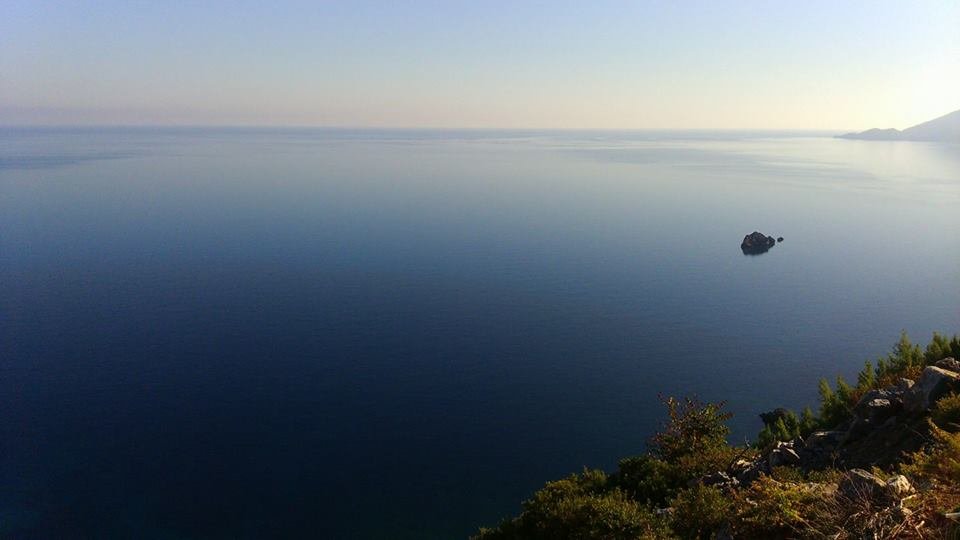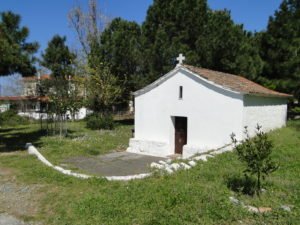Pili's History
The habitation of the area of Pili dates back to the Mycenaean period. Main fortified settlements of the classical and Hellenistic period have been founded in the past, closed to Kastri and Mesokotroni’s hills. The French journalist, Alexandre Buchon (1791-1846), references his book “Tour of the Greek Islands” to his visit to Pili in 1841. He wrote about the ancient objects (some of which were in the Archaeological Museum Chalkida) that were scattered in the village’s acropolis (today Mesokotroni hill). This acropolis was a little lower where there are the foundations of a medieval building called Pili’s castle and the ruins on the north side of the temple Saint John the Theologian, where the ancient Greek tower used to exist.

During the years of Ottoman rule, around the five naval miles northeast of Pili, there is an islet about which the old local people say that one of the villagers saw a boat full of Turks (possibly pirates or soldiers) heading towards Pili; he ran to warn the residents about the evil that was coming. So, the villagers, not enduring another looting, decided to pray and ask Saint John the Theologian (the historic church to which we will refer at length) to do something to save them from the rising evil.

The legend says that the prayer was heard and the Saint saved the Pili’s residents and the surrounding settlements, turning the ship to stone, and the Turks who were aboard the ship, to ants.
From there, it seems that the name of this small island, as “Xerokaravo” (Dry boat) and the ants that allegedly existed on it, came from.
Revolution of 1821 and liberation!
Native of Pili, Nathaniel Ioannou (1805-1880)
An unknown hero until today, and a priest from our homeland.
In the Greek revolution of 1821, an important personality of Pili is Archimandrite Nathaniel Ioannou. He was born probably in 1805, in Pili. He lived until his teenage years in Pili and then moved to the monastery of Karyes in Karystos. There, the future archimandrite received Education in Greek Letters. Remember, during the Turkish occupation, education took place mainly in monasteries. In this monastery, he learned the basics.
At the age of 16, he fought in Vrysakia, Vatsia, Karystos, Distomio, etc. Nathaniel Ioannou, along with the Evian chiefs of the Greek revolution Nikolaos Kriezotis, Vasos Mavrovouniotis, Aggeli Govio, Neophytos Adamos, was awarded the Silver Mint prize.
In 1824 he ordained a priest in the above monastery, where the inhabitants of the area and the surrounding villages appreciated him very much. After the encouragement of that period, Archimandrite of Karystia, Daniel Kontoudis (1833-1842), continued his high school education in a Greek school of the great generation’s teacher, Georgios Gennadiou (Central School). Afterward, he attended classes for four years at the Theological School of the University of Athens. In the last year of his studies, he was a priest of the Ecclesiastical Rizari School, a position which he received honorably for his renown. In total, his education in Athens lasted a decade.
In 1850 he went to Marseilles, France, to take the position of pastor and teacher of the Greek Orthodox Community. After five years in France, he was asked to introduce the so-called ” European Music ” to the Assumption Church, but he disagreed, so he decided to despite his refusal. This episode was a fact for which he later wrote and published the work “Speech on Ecclesiastical Music,” published in Ermoupolis of Syros in 1858.
Returning to Greece from Marseilles, he was appointed preacher of the Cyclades. He worked in Ermoupolis of Syros as an archimandrite and resigned in his old age, where he continued to live, loved and honored by the inhabitants and faithful of the area. He died on January 16, 1880, and was buried with great respect and sorrow.
Nathanael Ioannou was respected and virtuous recognized by the entire Greek Clergy. He proven, showed unprecedented patriotism.
In his will, he signed over his great library at the Theological School of Chalkida (1857-1893), which later was transferred to both the Public Library of Chalkida and the First High School for Boys of Chalkida. He also donated his small fortune to charities and the National University of Kapodistrias, where his name is written in the column of donors and benefactors.
Finally, a street in the city of Chalkida is honorably named after him.
Nathanael Ioannou published two books:
- Evia- Nathaniel Ioannou, Ermoupolis of Syros, 1857.
https://anemi.lib.uoc.gr/metadata/f/a/f/metadata-22-0000079.tkl
2.Discourse on Church Music, Ermoupolis, Syros, 1858.
https://anemi.lib.uoc.gr/metadata/a/0/e/metadata-70-0000154.tkl
The Kakia Skala's battle and the Heroes' sacrifice
In the book of Ioannis Mavromatis “History of the Struggle of the Revolution in Evia of 1821”, it is mentioned that only our neighboring village, Vlachia, was left untouched by the Ottomans thanks to the heroism of two Evian revolutionary chiefs, Athanasis Chondrovasilis and Vassilis Kokkalis. These two leaders with 400 Evians’ fighters repulsed the Ottomans and janissaries at Trialla and “Kakia Skala” (Pili-Vlachia’s road). Turkish foot did not step on Vlachia. Vassilis Kokkalis lost his life in this battle of “Kakia Skala”.
We propose to be honored with a monument in the Kakia Skala’s place, the above struggle of 400 Evian fighters with leader Vassilis Kokkalis. Also, to Nathaniel Ioannou, recognition with a memorial in Pili village; to a hero of the revolution of 1821 and later clergyman and Archimandrite scholar of the Greek and orthodox ecclesiastical tradition. Last, it’s imperative to do more extensive research on his life and work, to emerge his brave courage and his work from its place and vice versa.
In the book of Ioannis Mavromatis, “History of the Struggle of the Revolution in Evia of 1821”, it is mentioned that only our neighboring village, Vlachia, was left untouched by the Ottomans thanks to the heroism of two Evian revolutionary chiefs, Athanasis Chondrovasilis and Vassilis Kokkalis. These two leaders with 400 Evians’ fighters repulsed the Ottomans and janissaries at Trialla and “Kakia Skala” (Pili-Vlachia’s road). Turkish foot did not step on Vlachia. Vassilis Kokkalis lost his life in this battle of “Kakia Skala”.
We propose to be honored with a monument in the Kakia Skala’s place, the above struggle of 400 Evian fighters with leader Vassilis Kokkalis. Also, to Nathaniel Ioannou, recognition with a memorial in Pili village; to a hero of the revolution of 1821 and later clergyman and Archimandrite scholar of the Greek and orthodox ecclesiastical tradition. Last, it’s imperative to do more extensive research on his life and work; to emerge his brave courage and work from its place and vice versa.
Other articles related to Pili's history

TOPONYME
From where came Pili's name?

The magnesite
How this mineral influence the region's economic activity thru the years

Population variety
HOW HAS IT CHANGED OVER THE YEARS?

Saint Giannis' (the theologist) Church
OUR REGION'S MONUMENT
